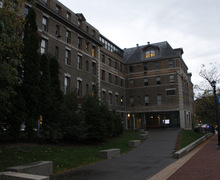Newhouse students share mixed reactions to BDJ, MND merger
Lars Jendruschewitz | Photo Editor
Newhouse expressed a range of support and frustration with the school's decision to merge its two journalism majors into one degree program. The change will not impact students currently enrolled in either major, and the decision will go into effect in the 2025 admissions cycle.
Get the latest Syracuse news delivered right to your inbox.
Subscribe to our newsletter here.
While scrolling on the social media platform Yik Yak, Chloe Kaiser said she came across a post about the “death of BDJ majors.” She initially thought it was a joke, but after looking it up, she saw that it was true: Syracuse University’s S.I. Newhouse School of Public Communications is merging its two journalism majors into one degree program next year.
“I was like, ‘Oh my god, it actually is real,’” Kaiser, a sophomore advertising student, said. “Things are changing, which I think is really exciting.”
Newhouse, which currently offers broadcast and digital journalism and magazine, news and digital journalism as two separate degrees, will merge the two into one bachelor of science program starting in fall 2025. While students who are currently enrolled in either major will not be impacted by this change, SU students expressed a range of support and frustration with the school’s decision.
Dean Mark Lodato and other Newhouse leaders said the merger follows years of discussion with faculty, alumni and other stakeholders about the best ways to prepare students for the multiple forms of storytelling and evolving demands of the journalism workforce. He said he expects the change will result in a rise of admissions and interest in journalism.
Many students, however, disagreed with this. Jillian Ward, a junior studying public relations, said maintaining targeted majors is critical for Newhouse’s reputation and appeal to prospective students. She also suggested that a lack of diversity in programs may deter students from attending the school.
“It’s very special that Newhouse has set niche courses and topics that are taught within the individual major programs,” Ward said. “If this is their attempt at trying to keep up, I feel like it just honestly is taking a step back … people won’t be as prepared to enter the industry and (students) not having a specialization won’t make them stick out.”
Ward said that Newhouse’s foundational courses, such as COM 107: Communications and Society and COM 117: Multimedia Storytelling, already provide journalism students with the diverse range of communication skills and knowledge that Newhouse aims to expand through the merger. She said there are distinctions between the two majors and combining them takes away from students’ passions.
Under the new degree framework, students majoring in journalism will keep several introductory courses common to both majors, with each of the separate tracks including three mandatory courses. A secondary track, sports media, will also be available for the BDJ and MND tracks.
I don’t want them to lose what makes each major unique.Juliet Seith, PR student
Sophomore Daisy Polowetzky, who said she chose Newhouse over other universities for its tailored MND curriculum, was similarly disappointed by the merger.
“I feel like for future students, having two combined majors of journalism kind of takes away from how special Newhouse is and can also make people in MND and BDJ feel like they are being clumped together and they’re not really as unique,” Polowetzky said.
She also said the merger could undermine the history of alumni accomplishments in the BDJ field specifically.
Some students saw potential benefits in offering broader exploratory courses for prospective and undecided students. Tommy Marquardt, a fourth-year student, said the way the majors are marketed isn’t always indicative of their subsequent academic experiences, so combining the majors could allow students flexibility to switch their major.
“I think it’s a good thing to let people kind of try some stuff out before they make a declaration like that,” Marquardt, a former BDJ major who has since switched to public relations, said.
Marketability and broader appeal to employers was a leading reason why students said they supported the merger. Kaiser said a broader journalism degree might be more advantageous for students in a changing job market, echoing Lodato’s thoughts.
Similarly, junior MND major Fei Chan said combining the two degrees might allow students to get a more well-rounded journalism education that includes visual communication skills, which have become increasingly important in the media industry. Bandier Program student Nina Dave agreed, pointing to the industry’s shift toward digital media.
“It really shows the growth in the industry and where the industry is going … everything is becoming more digital and print magazines are kind of going away,” Dave said.
Junior MND major Alix Berman said the specified training that makes Newhouse students excel in the magazine industry could be lost in a generalized MND track.
It really shows the growth in the industry and where the industry is going.Nina Dave, Bandier student
“The reason Newhouse students do so well within the magazine industry is because they’re trained so specifically … while other universities don’t train them like that,” Berman said. “I don’t know how they’re supposed to do that if simply MND is your track; not magazine, not news, not digital, it’s just MND as a whole.”
MND and BDJ are “very different programs” that require distinct courses, senior BDJ major Katie Nedder said. She said she was concerned that combining the majors might lead to an overwhelming number of students, given the high enrollment she’s seen in her BDJ classes.
Berman and sophomore Julia Condro both called the merger “frustrating,” as it could lead to BDJ overshadowing MND in a combined program. Berman said the prospect of taking classes she isn’t specifically interested in, such as sports- or broadcasting-specific courses, would turn her away from Newhouse.
“All MND people I know just want to write and want to do investigative journalism, they don’t want to be on camera or do sports,” Condro said.
Freshman public relations student Juliet Seith and BDJ majors Alex McGruder and Curran Coakley emphasized the importance of preserving the strengths of both majors, but said they are not opposed to the merger. Coakley said the mix of resources could offer broader opportunities for journalism students.
“At the end of the day, we are all journalists,” Coakley said. “I see the logic behind (the merge), but I would be interested to hear Newhouse’s reasoning behind combining them.”
Seniors Christina Kaden and Molly Lindstrom said that although combining the majors could result in a broader skill set, it also could lead to less focus on individual specializations. Kaden said it could ultimately lead to more confusion for new students who are already dealing with the “competitive” nature of Newhouse.
Seith shared similar sentiments, emphasizing that preserving the distinctness of each major is crucial.
“It’ll be interesting to see how (Newhouse stays) true to keeping them as separate entities through combining them,” Seith said. “I don’t want them to lose what makes each major unique.”
Published on August 29, 2024 at 12:22 am
Contact Samantha: saolande@syr.edu






